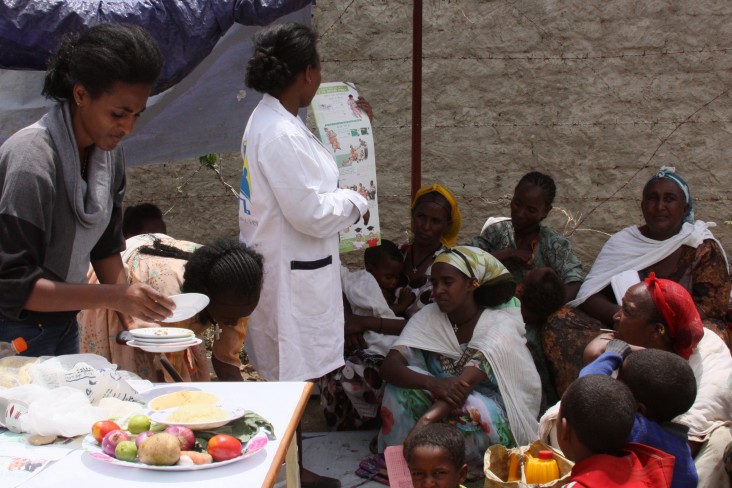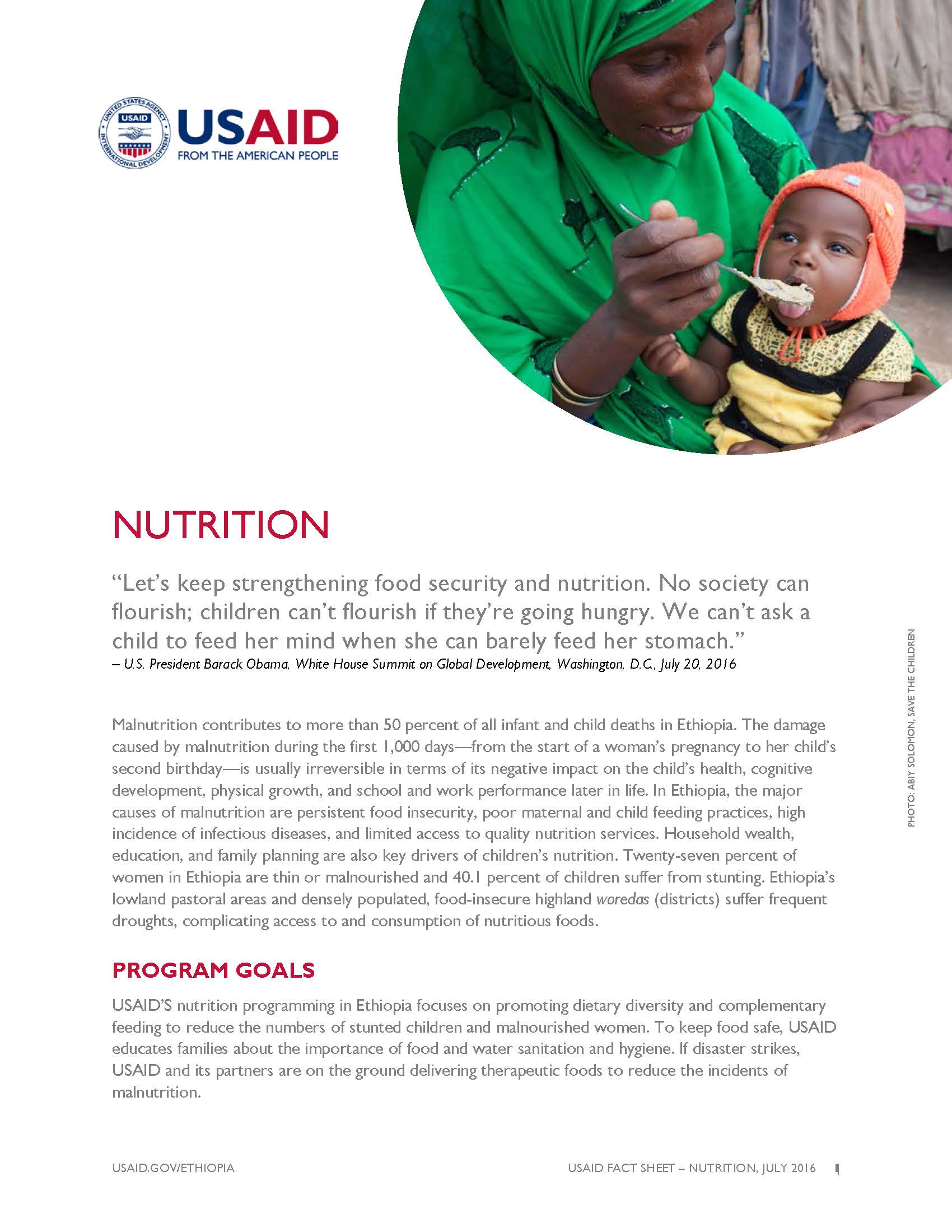
Twenty-nine percent of Ethiopian women are malnourished, and 44 percent of children suffer from chronic under-nutrition. Both micronutrient and protein-caloric malnutrition are complications for children, may stunt a child’s growth, and have other long-term implications for their development. In conjunction with the Feed the Future Initiative, the President’s Emergency Plan for AIDS Relief (PEPFAR) and other USAID programs to end hunger and improve nutrition, our nutrition activities provide technical assistance in developing national policy, programs, guidelines and institutional capacity to monitor undernourished populations. Nutrition assessment and counseling support is provided by us and our partners to hospitals and health centers, in addition to fortification and supplementation of micronutrients. We also combat malnutrition by providing training and materials for nutrition education on a community level.
Through our non-governmental organization partners, we support nutrition-related activities to reach food insecure households under the Productive Safety Net Program. These activities seek to improve the nutritional status of targeted communities with a focus on improving the quality of health services for pregnant and lactating mothers, raising awareness of healthy nutrition practices, improving the health, nutrition, water and sanitation status of children, developing the capacity of health extension workers, supporting community-based management of acute malnutrition, and harmonizing activities with the Ethiopian Government's health and nutrition initiatives, and providing nutritious food to mothers and children.
Activities Include
-
Solutions for African Food Enterprises: Increase the competitiveness of the Ethiopian wheat-processing sector and expand availability of affordable and nutritious foods in Ethiopia. A public-private partnership between TechnoServe and Partners in Food Solutions (General Mills, Cargill, and DSM), and USAID.
-
Development Food Assistance Program – Productive Safety Net Program: Improve the nutritional status of targeted communities with a focus on improving the quality of health services for pregnant and lactating mothers, raising awareness on healthy practices, and developing the capacity of health extension workers. Through our partners (Catholic Relief Services, Food for the Hungry-Ethiopia, Relief Society of Tigray, and World Vision), USAID is supporting nutrition-related activities to reach food insecure households under the Productive Safety Net Program. These activities seek to improve the nutritional status of targeted communities with a focus on improving the quality of health services for pregnant and lactating mothers, raising awareness of healthy nutrition practices, improving the health, nutrition, water and sanitation status of children, developing the capacity of health extension workers, supporting community-based management of acute malnutrition, and harmonizing activities with the Ethiopian Government's health and nutrition initiatives, and providing nutritious food to mothers and children.
-
Empowering New Generations in Improved Nutrition and Economic Opportunities: Uses sustainable, comprehensive, and coordinated interventions to improve the nutritional status of women and young children. Focuses on strengthening nutrition programs and policy, health care services, community-oriented nutrition and livelihood care and practices, and a rigorous learning agenda.
-
Food and Nutrition Technical Assistance III: Provides technical assistance in nutrition training at national and regional levels in reviewing and updating national HIV/AIDS nutrition policy and guidelines.
-
Growth through Nutrition: Uses sustainable, comprehensive, and coordinated interventions to improve the nutritional status of women and young children. Focuses on strengthening nutrition programs and policy, health care services, community-oriented nutrition and livelihood care and practices, access to clean water, and a rigorous learning agenda.
New Alliance for Food Security and Nutrition Activities in Ethiopia
-
Feed the Future Ethiopia Advanced Maize Seed Adoption Program: Help farmers transition from open-pollinated varieties of maize seed to higher yielding hybrid maize. DuPont Pioneer and USAID are investing more than $2 million to provide improved varieties of maize seed and technical assistance. A New Alliance for Food Security and Nutrition public-private partnership with the Ethiopian Ministry of Agriculture, Agricultural Transformation Agency, DuPont Pioneer, and USAID. Video. Photo Gallery.
Other USAID Activities that Promote Improved Nutrition in Ethiopia
-
Agricultural Growth Program – Livestock Market Development: Support the Government of Ethiopia’s Agricultural Growth Program by improving smallholder incomes and nutritional status through investments in selected livestock value chains. The activity provides technical assistance and grant-supported equipment investments to agro-processors in order to increase the output of meat and dairy products for domestic and international markets.
-
Feed the Future Ethiopia Value Chain Activity: Promote the commercialization of valuable foods typically produced by smallholders: maize, chickpea, coffee, livestock (meats), dairy, and poultry. Smallholders will improve their productivity, thereby enabling them to consume a greater portion of the nutritious foods they grow as well as earning stronger profits from the goods they sell to local, national and international markets.
-
Pastoralist Areas Resilience Improvement and Market Expansion: Target pastoral areas of Ethiopia to promote the viability and resiliency of pastoralist communities through market development and natural resource management. Graduate 50,000 households (200,000 people) in 16 districts from the Productive Safety Net Program through increased income and creation of assets that enhance their livelihoods potential.
Related Resources
-
The 'ENGINE' Behind Improved Nutrition in Ethiopia [Frontlines]
-
USAID Multi-Sectoral Nutrition Strategy 2014-2025 [PDF, 1 MB]
-
Government of the Federal Democratic Republic of Ethiopia National Nutrition Programme [PDF, 1 MB]
-
Agricultural Production and Children's Diets: Evidence from Rural Ethiopia [PDF, 1 MB]
Related News
-
USAID and World Food Programme Improved the Nutritional Status of People Living with HIV/AIDS (March 29, 2017)
-
USAID Activity Improves Maternal and Child Nutrition (September 15, 2016)
-
Better Communication Will Help Save Lives in Ethiopia (February 8, 2016)
-
Saving Lives with Puppets (February 4, 2016)
-
Patriarch of the Ethiopian Orthodox Tewahedo Church Endorses Nutrition Sermon Guide (January 12, 2016)
-
U.S. Congressional Delegation Looks at Impact of American-Ethiopian Development Cooperation (August 27, 2015)
-
U.S. Ambassador Visits Humanitarian and Health Assistance Sites in SNNPR (August 13, 2015)
-
Academic Center of Excellence for Nutrition Launched in Hawassa University (April 2, 2015)
-
Interfaith Roundtable for Action on Maternal/Child Health and Nutrition (March 19, 2015)
-
New Fortified Wheat Flour Launched by ASTCO Food Complex (March 17, 2015)
-
USAID and Irish Aid Collaborate to Help Transform Milk Production in Ethiopia (July 9, 2014)
-
Ethiopia Launches New Multi-Sector National Nutrition Program (June 24, 2013)
-
New Chickpea Products Launched by New Alliance for Food Security and Nutrition Partner Guts Agro Industry (April 10, 2014)
-
USAID Sponsored Innovation Lab to Improve Chickpea Production Launched in Ethiopia (February 24, 2014)
-
United States Senator Transfers Cross-Bred Dairy Heifers to Families in Chacha (January 22, 2014)
-
USAID and Project Mercy Transfer Cross-Bred Dairy Heifers to Dairy Farmers (November 25, 2013)
-
USAID Kicks Off School Milk Days Events (November 21, 2013)
-
USAID Awards Grants to Project Mercy to Boost Health and Livelihoods (June 20, 2013)
-
New Maize Public-Private Partnership Will Enhance Incomes of More Than 35,000 Farmers (May 17, 2013)
-
USAID Launches Camel Milk Project in Somali Region (April 25, 2013)
-
USAID Project to Increase Availability of Affordable and Nutritious Foods in Ethiopia (April 18, 2013)
-
USAID Launches New Program for Pastoralist Resilience Improvement and Market Expansion (December 18, 2012)
-
USAID Launches New Livestock Market Development Project (November 17, 2012)
-
Government of Ethiopia Leads Start-Up of New Alliance for Food Security and Nutrition with G-8 and Private Sector Partners (September 12, 2012)
-
US Launches Program to Improve the Nutrition of Mothers and Children (October 25, 2011)









Comment
Make a general inquiry or suggest an improvement.